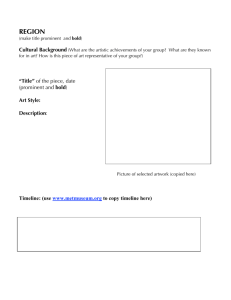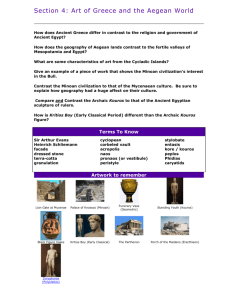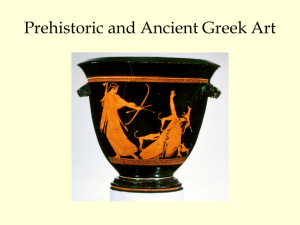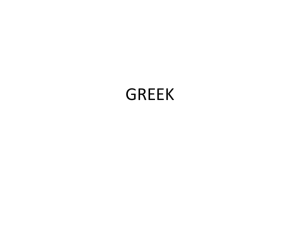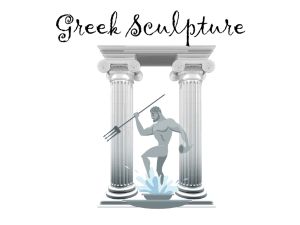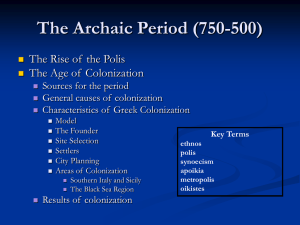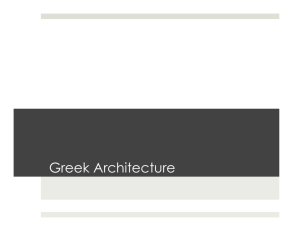Chapter05-Greece Geometric to Archaic
advertisement
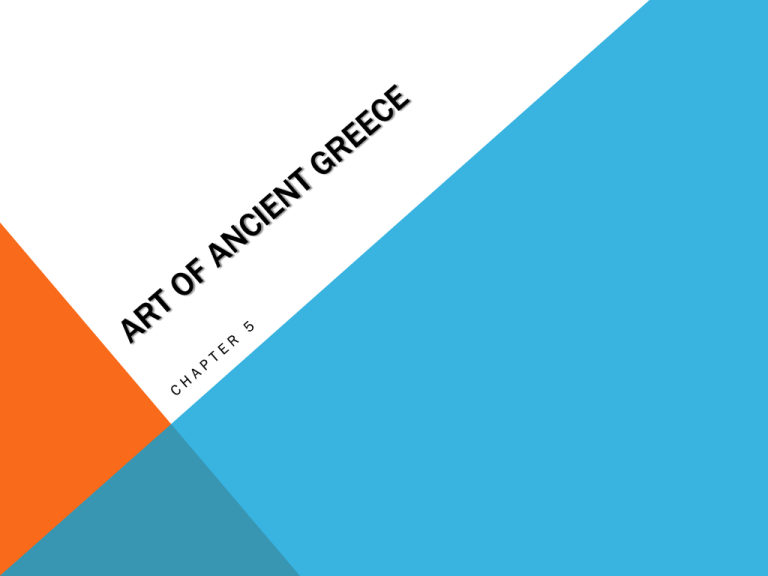
KEY TERMS • Sanctuaries • Rosettes • Black-figure • Red-figure • Olpe • Caryatids/Atlantids • Kantharos • Symposium • Contrapposto • Douris • Stoa • Gigantomachy • Titanomachy HISTORICAL BACKGROUND City-states Athens was commercial and cultural center Sparta was center of war Only men could be citizens Polytheistic Athletics and beauty were important Buildings were more important aesthetically than those in Egypt Ancient Greek Art Can be classified into the following categories: Geometric Period ca. 900-700 B.C.E. Orientalizing Period ca. 725-600 B.C.E. Archaic Period ca. 625-480 B.C.E. --- Greeks defeat Persians 480-479 BCE --- Early Classical Period ca. 480-450 B.C.E. High Classical Period ca. 450-400 B.C.E. Late Classical Period ca. 400-330 B.C.E. Hellenistic Period ca. 330-31 B.C.E. Ancient Greek Art Mesopotamian = Worship Egyptian = Afterlife Greek = Humanism The Geometric Period The beginning of Greek art is found in painted pottery and small scale sculpture. Artists established different categories of shapes of ceramic vessels- most important was the amphora - twohandled vase used to carry wine and oil Around 800 BC, pottery began to move away from purely non-objective designs - ornamental figures. Dipylon Vase was a grave monument bottom has holes through which liquid offerings filtered down to the dead below- done in remembrance rather than to appease the soul of the dead. Geometric Krater from the Dyplon Cemetery Athens, Greece, ca. 740 BC The Geometric Period The vase functions as a grave marker depicting the funeral procession of an obviously well respected individual. The magnitude of his funeral procession speaks to the wealth and position of the deceased family in the community. Contains no reference to an afterlife The nature of the ornamentation of these early works has led art historians to designate these as GEOMETRIC. (all empty spaces are filled with circles and M-shaped ornament. No open spaces.) Geometric Krater from the Dyplon Cemetery Athens, Greece, ca. 740 BC Geometric Krater from the Dyplon Cemetery Athens, Greece, ca. 740 BC The Geometric Period Hero and Centaur ca. 750-730 BC The image of the man is thought to be Herakles battling the Centaur. This image demonstrates the Geometric artist not being limited to depicting scenes from daily life. The centaur is a purely Greek invention that has obviously created a problem for this artist, as no such creature has ever been seen. Even at the beginning of Greek figural art, we can see the instinct for the natural beauty of the human figure . This concept is reflected in the fact that Greek athletes exercised without their clothes and even competed nude in the Olympic Games from very early times. Orientalizing Period Late 7th cent. BCE Olpe-Black Figure Greek, Corinth, 650 - 625 B.C. Terracotta 12 15/16 x 6 11/16 in. Rosettes The Orientalizing Period This is an example of a kore figure. (plural korai) It is still uncertain whether this figure was meant to represent a mortal or a deity. The hand across the chest is thought to be an indication of prayer, referencing that this is a probably a kore. The image has a monumental quality, but it is only about 2 feet tall (still larger that the bronze statuettes of the era) Lady of Auxerre, statue of a goddess or kore Greece ca. 650 - 625 BC Archaic Period 600-480 BCE Not what we would expect “Archaic” to mean. Simply means it is the beginning of formalized art. Archaic Period 600-480 BCE Reconstruction of the Sanctuary of Apollo, Delphi Archaic Period 600-480 BCE Temple of Hera I (Roman Paestum) 550-540 BCE Archaic Period 600-480 BCE Treasury of the Siphnians, Delphi Archaic Period 600-480 BCE West Pediment at the Temple of Aphaia Dying Warriors The Archaic Period Male figures called kouros meaning “youth” were always depicted nude. This particular kouros figure was said to have a funerary purpose, as it once stood over a grave in the countryside near Athens. Statues such as this replaced the Geometric vases as the preferred form of grave marking. Despite the similarity with the Egyptian prototype for figurative sculpture, these kouros figures differ in many significant ways… Kouros Greece ca. 600 BC The Archaic Period How are Mentuemhet and the Kouros different? Mentuemhet, Egypt, Dynasty XXVI, 650 BC Kouros Greece ca. 600 BC The Archaic Period •This work was found in the acropolis in fragments. • The sculpture contains an inscription in the base that dedicates the creation of the statue to a man named Rhonbos, of whom many think the calf bearer is a portrait. • Significant is the beard and cloak, which clearly removes this figure from the idea of male youth that the kouros figures contained. • From this time on, Archaic sculpures seem to smile- even in inappropriate contexts •The calf’s legs join with the hands of the figure to form an “X” that unites the two both physically and formally. •“Archaic smile” indicates life. Calf Bearer (Moschophoros) Athens, Greece ca. 560 BC (Anavysos) Kroisos Anavysos, Greece ca. 530 BC The Archaic Period •Around 530 BC a man named Kroisos died a hero’s death in battle. His grave was marked by this figure. • The inscription at the base of this statue read: “stay and mourn at the tomb of dead Kroisos, whom raging Ares destroyed one day as he fought in the foremost ranks” • The “archaic smile” is present, as is the Egyptian stance, but the naturalism of the body far exceeds any figurative sculpture that preceded it. • Head is no longer too large for the body, the cheeks are full and rounded, the abdomen is well developed and natural, the hair is less stiff , and rounded hips have replace the V-shaped ridges of the New York kouros. Some of the original paint has survived, giving the sculpture an even more naturalistic appearance. The flesh was left the natural color of the stone, but the hair, lips, and eyes were painted in encaustic (pigment mixed with hot wax) The Archaic Period Titled “Peplos Kore” because of the peplos that the figure is wearing. ( a simple, long, woolen belted garment that gives the female figure a columnar appearance. This sculpture was damaged during the sack of the Acropolis in 480 BC by the Persians. This sculpture once stood as a votive offering in Athena’s sanctuary. Peplos Kore Athens, Greece ca. 530 BC The Archaic Period Influence of the Ancient Near East The Archaic Period Detail from an Athenian black-figure amphora created by Exekias (painter and potter) Exekias was considered by the Greeks to have been a Master of black figure painting. No series of horizontal bandsinstead a simple large band that contains the didactic image. The earliest of these types of vase paintings were called bilingual due to their depiction of the same subject on both sides of the vase. One in red-figure, and the other in black-figure. The “calm before the storm”, a concept that is repeated throughout the history of art. Exekias, Achilles and Ajax playing a dice game. Vulci, Italy ca. 540 -530 BC The Archaic Period Exekias, Death of Ajax. Vulci, Italy ca. 540 -530 BC Trojan War scene The Archaic Period Amasis Painter, DIONYSOS WITH MAENADS. ca. 540 BC The Archaic Period Euphronios (Painter), DEATH OF SARPEDON. ca. 515BC
